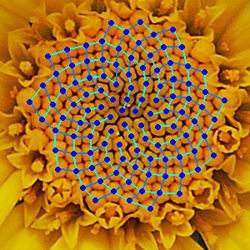| Part of a series on | ||
| Mathematics | ||
|---|---|---|
|
|
||
|
| ||
| Part of a series on |
| Biology |
|---|

Mathematical and theoretical biology, or biomathematics, is a branch of biology which employs theoretical analysis, mathematical models and abstractions of living organisms to investigate the principles that govern the structure, development and behavior of the systems, as opposed to experimental biology which deals with the conduction of experiments to test scientific theories.[1] The field is sometimes called mathematical biology or biomathematics to stress the mathematical side, or theoretical biology to stress the biological side.[2] Theoretical biology focuses more on the development of theoretical principles for biology while mathematical biology focuses on the use of mathematical tools to study biological systems, even though the two terms are sometimes interchanged.[3][4]
Mathematical biology aims at the mathematical representation and modeling of biological processes, using techniques and tools of applied mathematics. It can be useful in both theoretical and practical research. Describing systems in a quantitative manner means their behavior can be better simulated, and hence properties can be predicted that might not be evident to the experimenter. This requires precise mathematical models.
Because of the complexity of the living systems, theoretical biology employs several fields of mathematics,[5] and has contributed to the development of new techniques.
- ^ "What is mathematical biology | Centre for Mathematical Biology | University of Bath". www.bath.ac.uk. Archived from the original on 2018-09-23. Retrieved 2018-06-07.
- ^ "There is a subtle difference between mathematical biologists and theoretical biologists. Mathematical biologists tend to be employed in mathematical departments and to be a bit more interested in math inspired by biology than in the biological problems themselves, and vice versa." Careers in theoretical biology Archived 2019-09-14 at the Wayback Machine
- ^ Longo G, Soto AM (October 2016). "Why do we need theories?" (PDF). Progress in Biophysics and Molecular Biology. From the Century of the Genome to the Century of the Organism: New Theoretical Approaches. 122 (1): 4–10. doi:10.1016/j.pbiomolbio.2016.06.005. PMC 5501401. PMID 27390105.
- ^ Montévil M, Speroni L, Sonnenschein C, Soto AM (October 2016). "Modeling mammary organogenesis from biological first principles: Cells and their physical constraints". Progress in Biophysics and Molecular Biology. From the Century of the Genome to the Century of the Organism: New Theoretical Approaches. 122 (1): 58–69. arXiv:1702.03337. doi:10.1016/j.pbiomolbio.2016.08.004. PMC 5563449. PMID 27544910.
- ^ Robeva R, Davies R, Hodge T, Enyedi A (Fall 2010). "Mathematical biology modules based on modern molecular biology and modern discrete mathematics". CBE: Life Sciences Education. 9 (3). The American Society for Cell Biology: 227–40. doi:10.1187/cbe.10-03-0019. PMC 2931670. PMID 20810955.